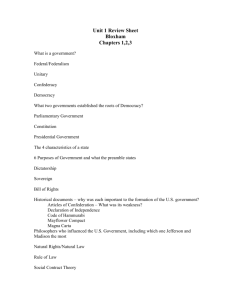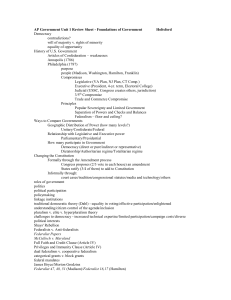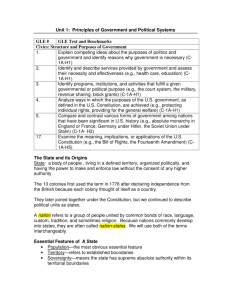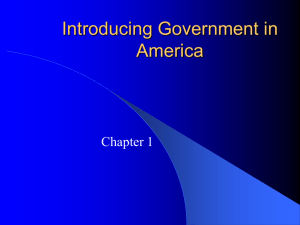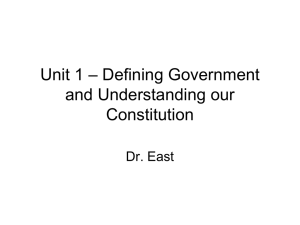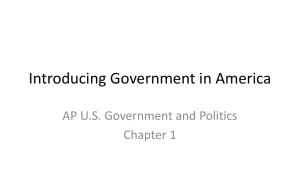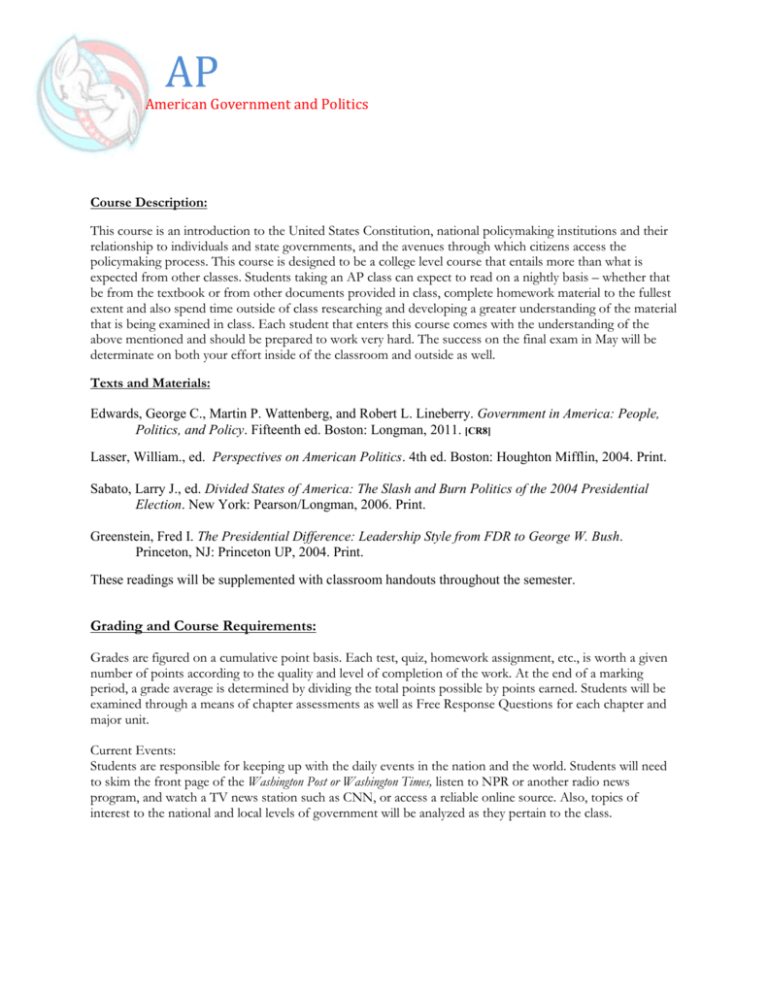
AP
American Government and Politics
Course Description:
This course is an introduction to the United States Constitution, national policymaking institutions and their
relationship to individuals and state governments, and the avenues through which citizens access the
policymaking process. This course is designed to be a college level course that entails more than what is
expected from other classes. Students taking an AP class can expect to read on a nightly basis – whether that
be from the textbook or from other documents provided in class, complete homework material to the fullest
extent and also spend time outside of class researching and developing a greater understanding of the material
that is being examined in class. Each student that enters this course comes with the understanding of the
above mentioned and should be prepared to work very hard. The success on the final exam in May will be
determinate on both your effort inside of the classroom and outside as well.
Texts and Materials:
Edwards, George C., Martin P. Wattenberg, and Robert L. Lineberry. Government in America: People,
Politics, and Policy. Fifteenth ed. Boston: Longman, 2011. [CR8]
Lasser, William., ed. Perspectives on American Politics. 4th ed. Boston: Houghton Mifflin, 2004. Print.
Sabato, Larry J., ed. Divided States of America: The Slash and Burn Politics of the 2004 Presidential
Election. New York: Pearson/Longman, 2006. Print.
Greenstein, Fred I. The Presidential Difference: Leadership Style from FDR to George W. Bush.
Princeton, NJ: Princeton UP, 2004. Print.
These readings will be supplemented with classroom handouts throughout the semester.
Grading and Course Requirements:
Grades are figured on a cumulative point basis. Each test, quiz, homework assignment, etc., is worth a given
number of points according to the quality and level of completion of the work. At the end of a marking
period, a grade average is determined by dividing the total points possible by points earned. Students will be
examined through a means of chapter assessments as well as Free Response Questions for each chapter and
major unit.
Current Events:
Students are responsible for keeping up with the daily events in the nation and the world. Students will need
to skim the front page of the Washington Post or Washington Times, listen to NPR or another radio news
program, and watch a TV news station such as CNN, or access a reliable online source. Also, topics of
interest to the national and local levels of government will be analyzed as they pertain to the class.
Reading Assignments and Course Calendar
Unit One: (September 10 – 21)
Introducing American Government: The first unit of the semester will analyze the key functions of
government and students will be able to explain why they are important to the day to day course of
government and people living inside of the United States. This first unit will allow for an introduction as to
what are politics and how citizens can have a basic impact on public policy and conversely, how those policies
can impact people. Finally, students will be able to also identify the key principles of democracy and outline
theories regarding how it works in principle and the challenges democracy faces today.
Reading for the Unit: Edwards, et al., Chapter 1
Woll, Chapter 1: “Second Treatise of Civil Government” p. 4-9
“Founding Fathers: Reform Caucus in Action” p. 9-30
Introduction to the AP Free Response Question (FRQ Survival Guide)
Unit Two: (September 24 – October 5)
The Constitution: In the second unit of the course, students will examine the Constitution and when they are
finished they will be able to describe the ideas behind the American Revolution and their role in shaping the
current constitution that we continue to have to this day. Also, unit two will revolve around the process of
developing the new Constitution, by examining the weaknesses of the Articles of Confederation that lead to
the Constitutional Convention and students will be able to categorize the issues that came up while the
convention was in session as well as the resolutions reached for each issue. Along with the above mentioned,
the students will also discover how Madison played an important part in developing a system that addressed
the dilemma of majority rule, while protecting minority interests. In this process students will also address the
formal and informal manner by which the Constitution is revised. Finally, the students will be able to
compare and contrast the backgrounds and positions of both the Federalists and the Anti-Federalists and
how their arguments shaped the ratification process of the Constitution.
Reading for the Unit: Edwards, et al., Chapter 2
Teacher created Handout discussing Locke, Hobbes, and Montesquieu
Woll, Chapter 1: “Framing the Constitution,” pp. 31 – 41
“Federalist 47, 48, 51” pp. 42 – 46
Free Response Question #1 – Philosophy of the Constitution
Unit Three: (October 8 – 26)
Federalism: Through an examination of mostly primary sources, the students will gain an understanding of
how the Federal system was developed and hoped to protect individual liberties while at the same time
guarantee a national government that could be held together as a union. The students will be able to define
federalism and explain its consequences for American politics, outline how a federal system creates
obligations from both the state and the federal governments to each other, and access the shift from dual
federalism to cooperative federalism and how the role of fiscal federalism is a major player in
intergovernmental actions today.
Reading for the Unit: Edwards, et al., Chapter 3
Woll, Chapter 2: “Federalist 16, 17” pp. 53 – 57
“The Anti-Federalist Papers No. 17” pp. 58 – 61
“Federalist 39” pp. 66 – 71
“McCulloch v. Maryland” pp. 75 – 78
Free Response Question #2– Fiscal Federalism
Unit Four: (October 29 – November 9)
Civil Liberties and Public Policy: In unit four we will discuss and analyze the process by which civil liberties
have been extended to the states and to the individual people of the United States. Students will be able to
trace the process by which the Bill of Rights have been applied to the states as well as distinguish between the
different rights that are protected under the Bill of Rights. When finished with this unit students will be able
to distinguish between the two types of religious rights, differentiate the rights of free expression, describe the
rights to assemble and associate, describe the right to bear arms, the rights that defendants have in a legal
realm and also trace the evolution of the right to privacy.
Reading for the Unit: Edwards, et al., Chapter 4
Woll, “Anti-Federalist Paper No. 84 (On the Lack of a Bill of Rights)” pp. 104 - 107
Lasser, “”On Liberty” pp 86 – 92
“Terrorism and the Limits of Law” pp. 94 - 98
Free Response Question #3 – The War on Terror and the USA PATRIOT Act
Unit Five: (November 13 – 28)
Civil Rights and Public Policy: This unit will consist of what made/makes up the Civil Rights movement in
the United States and how civil rights are a continually shifting field of study. This will be accomplished by
students being able to differentiate the three different levels of review for Supreme Court cases, fully
understand and examine the Fourteenth Amendment and the equal protections clause, trace the evolution of
women’s rights and gender issues, analyze other forms of civil rights (seniors, people with disabilities, gays,
etc.), as well as trace the evolution of affirmative action policy and assess the arguments for and against such
policies.
Reading for the Unit: Edwards, et al., Chapter 5
Woll, “Plessy v. Ferguson” pp.127 – 129
“Brown v. Board of Education of Topeka” pp. 130 – 133
“Engel v. Vitale” pp. 142 – 148
“The Right to Privacy” pp. 149 – 151
“Griswold v. Connecticut” pp. 152 – 154
“Roe v. Wade” pp. 155 - 163
“University of California Regents v. Bakke” pp. 165 – 167
Free Response Question #4 – Analysis of Brown v. Board
Unit Six: (November 29 – December 11)
Public Opinion and Political Action: This section of the class will revolve around how American citizen’s
opinions affect the way in which policy is directed. Students will examine the demographic trends and how
they will likely impact political action and how they outline various forms of socialization and how that
socialization shapes public opinion. Also, students will discuss and examine polls, and how they work as well
as assess the influence political ideologies have on American politics and behavior. Finally, students will also
be able to classify forms of political participation into two broad types – Conventional Participation and
Protest Participation.
Reading for the Unit: Edwards, et al., Chapter 6
Lasser, “One Nation, Slightly Divisible” pp. 154 – 161
Jost, Federico, & Napier, “Political Ideologies: Its Structure, Functions, and Elective
Affinities” pp. 323 – 328
Smith, “Beyond Tocqueville, Myrdal, and Hartz: The Multiple traditions in America”
pp.550 – 552, 554 – 558
Free Response Question #5 – How People Take Action!
Unit Seven: (December 12 – 21)
The Mass Media and Political Agenda: Media plays a huge part in the shaping of the spectrum of
American politics and therefore students must review how the media develops, shift, changes, or hold our
political ideologies and beliefs. To be able to do this effectively; students must be able to understand that
politics and media go hand in hand. At the end of unit seven students will be able to describe how American
politicians choreograph their messages through the mass media, outline the key developments in the history
of mass media and American Politics, list the major criteria that determine which news stories receive the
most attention, analyze the impact the media has on what policy issues Americans think about, and explain
how policy entrepreneurs employ media strategies to influence the public agenda.
Reading for the Unit: Edwards, et al., Chapter 7
Lasser, “New York Times Co. v. United States” pp. 206 – 208
“Bias” pp. 209 - 211
Sabato, Chapter 8: “A New Media” pp.179 – 187
Free Response Question #6 – Mass Media and the Presidency
Unit Eight: (January 7 – 18)
Political Parties: While Madison opposed the ideas of factions and the problems that may arise from them,
there is no doubt that political parties play a large role in the development of political beliefs and political
understanding in American politics. They influence policy, they influence votes, they sway decisions on
Capitol Hill and they play a part in American people’s daily lives. Therefore, at the end of this unit students
will be able to identify the function that political parties perform in American democracy, determine the
significance of party identification, describe, how political parties are organized, evaluate how well political
parties generally do in carrying out their promises, differentiate the various party eras in history, assess both
the impact of third parties on American politics and their limitations, and evaluate the advantages and
disadvantages of responsible party government.
Reading for the Unit: Edwards, et al., Chapter 8
Woll, “Federalist 10” pp. 177 – 181
“Government by Discussion” pp. 185 – 189
Lasser, “Towards a More Responsible Two-Party System” pp. 229 – 234
Democratic and Republic Campaign Platforms provided on the internet
Free Response Question #7 – Decline of Political Parties
Unit Nine: (January 22 – February 1)
Nominations, Campaigns and How America Votes: The process by which we come to a decision of who
will represent us in our elected bodies of government is a long and deliberate process. It is the very
foundation by which people make their decisions because the people that Americans elect will be the people
that make the much larger decisions for our country in the end. This process is thought out and constructed
by campaigns in a way to make a candidate the most attractive person for the job and in the end allow for a
candidate to win the position. While it may seem very basic, there is great thought that goes into the process
of campaigns and the evaluation of how Americans vote in the United States. When finished with this unit,
students will be able to evaluate the fairness of our current system of presidential primaries and caucuses,
explain the key objectives of all campaigns, outline how fund-raising for federal offices is regulated by
campaign finance laws, determine why campaigns have an important, yet limited, impact on election
outcomes, assess the advantages and disadvantages of a long presidential campaign, distinguish the types of
elections, trace the evolution of the American electoral process from 1800 to present, identify the factors that
influence whether people vote or not, assess the impact party identification, candidate evaluations, and policy
opinions have on voting, evaluate the fairness of the Electoral College system for choosing the president and
assess the extent to which elections make government officials pay attention to what voters want.
Reading for the Unit: Edwards, et al., Chapters 9 & 10
Sabato, “Nominations and Conventions” pp. 1 – 24
Howard R. Ernst, “The Housing Gap: A Political Analysis of American Voters by
Housing Tenure” (Scholarly Article)
Woll, “Democratic Practice and Democratic Theory” pp. 209 – 215
“The Responsible Electorate” pp – 216 – 220
Free Response Question #8 – Voters and Party Identification
Unit Ten: (February 4 – 14)
Interest Groups: When looking at how policy is directed in the United States, it would be unreasonable to
leave out interest groups from such a conversation. They are the groups of people that come together with
issues that are pressing to the American people and they unite to attempt to influence change on the policy
making process. They enter the policy field through many different means, but they have primary goals and
will use the means at their disposal to reap the results they desire. Interest groups shape American politics
through developing means by which all people can access the political spectrum. This unit will allow students
to describe the role of interest groups in American politics, compare and contrast the theories of pluralism,
elitism, and hyperpluralism, analyze the factors that make some interest groups more successful than others in
the political arena, assess the four basic strategies that interest groups use to try to shape policy, identify the
various types of interest groups and their policy concerns, and evaluate how well Madison’s ideas for
controlling influence of interest groups has worked in practice.
Reading for the Unit: Edwards, et al., Chapter 11
Woll, “Madison’s Dilemma” pp. 222 – 226
“Citizens United, v. Federal Election Commission” pp. 233 – 237
“The Role of Interest Groups in Government” pp. 247 – 248
“The Misplaced Obsession with PACs” pp. 249 – 256
Michael S. Kang, “After Citizens United” Indiana Law Review, pp. 243 – 254
Free Response Question #9 – PAC Contributions
Unit Eleven: (February 25 – March 8)
The American Congress: Conceived by the Framers as the center of policymaking in the United States, the
Legislature is the body of government charged with attempting to run the government as smoothly as
possible. The plan has always been that the great policy disputes of the nation would be settled by a nonviolent, representative group of members that would make decisions for the betterment of the nation as a
whole. While this is not a perfect science, it removed the power of decision making away from a strong White
House or the possibility of an even stronger Supreme Court. It is the members of this body of government
that are affected by our votes, interest groups and public support which all make it a very tough job. Students
will be able to characterize the backgrounds of members of Congress and assess their impact on the ability of
members of Congress to represent average Americans, identify the principal factors influencing the outcomes
in congressional elections, compare and contrast the House and Senate, and describe the roles of
congressional leaders, committees, caucuses and staff; outline the path of bills to passage and explain the
influences on congressional decision making; and assess Congress’s role as a representative body and the
impact of representation on the scope of government.
Reading for the Unit: Edwards, et al., Chapter 12
Woll, “Federalist 53, 56, 57, 58, 62, 63” pp. 312 – 318
“Congressional Government” pp. 320 – 324
“Congress: The Electoral Connection” pp. 339 – 344
Lasser, “Changing Perceptions of the British System” pp. 275 – 278
Free Response Question #10 – Nonlegislative Functions of Congress
Unit Twelve: (March 11 – 19)
The Presidency: The presidency is an institution composed of the roles of presidents must play, the powers
at their disposal, and the large bureaucracy at their command. It is also a highly personal position. The
personality of the individual serving as president makes a difference. It is the highest position in all of the land
and is constantly being changed and shifted because of influences that are outside the control of the person in
the office. As chief executive the president is effectively supposed to manage our budget, execute our wars,
defend our populace and continually make their presence known as a symbol of our country. When finished
with this unit, students will be able to characterize the expectations for and the backgrounds of presidents and
identify paths to the White House and how the president may be removed, evaluate the president’s
constitutional powers and the expansion of presidential power, describe the roles of the vice president,
cabinet, Executive Office of the President, White House staff, and First Lady; assess the impact of various
sources of presidential influence on the president’s ability to win congressional support, analyze the
president’s powers in making security policy and the relationship between the president and Congress in this
arena, identify the factors that affect the president’s ability to obtain public support, characterize the
presidents relations with the press and news coverage of the presidency, assess the role of presidential power
in the American democracy and the presidents impact on the scope of government.
Reading for the Unit: Edwards, et al., Chapter 13
Lasser, “Federalist No. 68 & No. 70” pp. 289 - 293
Woll, “George Washington and the Origins of the American Presidency” pp. 263-265
“Boumediene et al. v. bush, President of the United States” pp. 293 - 296
Greenstein, Chapter 14 “Lessons from the Modern Presidency” pp. 217 - 223
George Washington “First Inaugural Address” pp. 1 – 3
Free Response Question #11 – Presidents and Their Cabinets
Unit Thirteen: (March 20 – 29)
The Federal Bureaucracy and the Budget: Especially in our current political state, the budget and the
players who help to shape the budget are increasingly important. Policy has been directed to make the budget
a pressing issue on any bill or action of Congress. Both policy and political parties have different views of
how the budget can be improved and how this will be accomplished. In the end, the groups that make up the
federal bureaucracy are affected by this giant budget and therefore, require a closer examination as well.
Students will be able to describe the sources of funding for the federal government and assess the
consequences of tax expenditures and borrowing, analyze federal expenditures and the growth of the budget,
outline the budgetary process and explain the role politics plays, and assess the impact of democratic politics
on budgetary growth and the budget on the scope of government. Students will also be able to describe the
federal bureaucrats and the ways in which they obtain their jobs, differentiate the four types of agencies into
which the federal bureaucracy is organized, identify the factors that influence the effectiveness of bureaucratic
implementation of public policy, describe how bureaucracies regulate, and assess deregulation and alternative
approaches to regulation, and assess means of controlling unelected bureaucrats in American democracy and
the impact of the bureaucracy on the scope of government.
Reading for the Unit: Edwards, et al., Chapters 14 & 15
Woll, “Constitutional Democracy and Bureaucratic Power” pp. 298 – 301
Current event articles pertaining to the 2012 Fiscal Cliff Showdown
Free Response Question #12 – Why is the Civil Service Important?
Unit Fourteen: (April 8 – 16)
The Federal Courts: the courts offer Americans a unique and informal means by which to influence change
in government policy, however, this process is long and cumbersome but offers an adversarial system by
which two people can bring their conflict to an independent arbiter to come to a resolution. This system
allows for justice to reveal itself trough the proper channel of the law and codes of the nation. The courts
have played, and continue to play, a major part in the political process because of the many differences and
values of legislators and people in the United States. This offers a unique opportunity to analyze different
cases and seminal moments of the court and how they have shifted the political spectrum of the United
States. At the culmination of this unit, students will be able to identify the basic elements of the American
judicial system and the major participants in it, outline the structure of the federal court system and the major
responsibilities of each component, explain the process by which judges and justices are nominated and
confirmed, describe the backgrounds of judges and justices and assess the impact of background on their
decisions, outline the judicial process at the Supreme Court level and assess the major factors influencing
decisions and their implementation, trace the Supreme Court’s use of judicial review in major policy battles in
various eras of American history, and assess the role of unelected courts and the scope of judicial power in
American democracy.
Reading for the Unit: Edwards, et al., Chapter 16
Woll, “Federalist 78” pp. 358 – 362
“Marbury v. Madison” pp. 363 – 365
“How the Supreme Court Arrives at Decisions” pp. 382 – 388
“The Obligation to Follow Precedent” pp. 390 – 391
Current event articles considering ‘ObamaCare’ and Immigration
Free Response Question #13 – Checks and Balances
Unit Fifteen: (April 17 – 26)
Policymaking – The Economy, Society, and the Environment: This unit will encompass a large amount of
material that will thoroughly analyze the way in which policy is made in the United States and how the
economy, social welfare, health care, the environment and energy all affect policymaking. When finished,
students will be able to assess the role government has in our mixed economy, identify the two main policy
tools that American government can employ to address economic problems, analyze the impact of the global
economy on American economic policymaking, describe the economic policy interests of business, labor
unions, and consumers, compare and contrast the entitlement and means-tested social welfare programs,
assess the extent of economic inequality in America and the role of government in lessening it, trace the
changes over time in major federal welfare programs, outline how America’s Social Security program works
and the challenge of keeping it financially solvent in the coming years, distinguish American social welfare
policy from that of other established democracies, outline the problems of health care in America and the
role of government in health care, analyze the conflicts between economic growth and environmental
protection, and identify the major national environmental protection policies; evaluate the advantages and
disadvantages of each of the principal sources of energy in the United States, and assess how all of these
affect American democracy and the scope of government.
Reading for the Unit: Edwards, et al., Chapters 17, 18 & 19
Lasser, “Domestic Policy Making” pp. 377 – 381
Current event articles discussing the economy, the environment, and social issues
Free Response Question #14 – Entitlements v. Means-Tested
Unit Sixteen: (April 29 – May 3)
National Security: In a world of terrorism, anti-western conflict, sectarianism and constant conflict in some
way or another, the United States is constantly on an altered level of security. This was extremely heightened
by the terrorist attacks of September 11, 2001, and has continued to shape policymaking since. National
security is one of the largest driving factors for policy, budget, international relations and domestic
partnerships and plays a large role in our day to day activities. When completed with this unit students will be
able to identify the major instruments and actors in making national security policy, outline the evolution of
and major issues in American foreign policy through the end of the Cold War, explain the major obstacles to
success in the war on terrorism, identify the major elements of U.S. defense policy, analyze the evolving
challenges for the U.S. national security policy, and assess the role of democratic politics in making national
security policy and the role of national security policy in expanding government.
Reading for the Unit: Edwards, et al., Chapter 20
CRS Report for Congress: The USA PATRIOT Act: A Sketch
Harry Giroux, “War on Terror: The Militarizing of Public Space and Culture in the
United States” pp. 211 – 221
George P. Schultz, et al, “A world Free of Nuclear Weapons” The Wall Street Journal
Free Response Question #15 – Congress and Foreign Policy
Unit Seventeen: (May 6 – 10)
The New Face of State and Local Government: The interaction of the state and local with the federal
government and with each other is evolving and changing. They play a much larger part in people’s lives than
they have in the past and this is being ushered in by an era of devolution and the returning power of these
local governments. These subnational governments have been given greater amounts of authority and action
as are being asked to do even more in the future to help regulate our broad and changing country. This unit
will allow students to describe how state constitutions differ and a common process for amending state
constitutions, summarize recent patterns in partisan competition in state elections and party control in state
government, outline the roles and responsibilities of governors and distinguish their formal and informal
powers, describe the functions of state legislatures and contrast state legislature with those of the past, outline
the basic elements of most state court systems, and describe the various methods for selecting state judges,
differentiate types of direct democracy, and evaluate direct democracy, explain Dillon’s rule, and differentiate
five types of local government, contrast state revenue and expenditures with local revenue and expenditures
and outline ways state and local governments have tried to increase revenue, and assess the democratic
elements and the problems of state and local governments.
Reading for the Unit: Edwards, et al., Chapter 21
The Washington State Constitution
Peter H. Schuck, “Introduction: Some Reflections on the Federalism Debate” pp. 5-9
Diane Lang, “Dillon’s Rule…and the Birth of Home Rule” pp. 1-5
Free Response Question #16 – Cooperative Federalism
Unit Eighteen:
Final and Preparation for the AP® Exam! The Exam is at 8am on May ?
Unit Nineteen: (May ? – June 19)
Life after the Exam!



